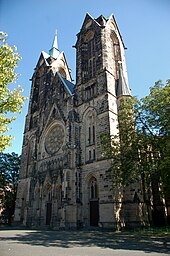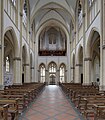St. Joseph (Munster)
The Catholic parish church of St. Joseph is located in the southern district of Münster , Westphalia , on Hammer Strasse.
history
In view of the increased population, the decision was made in 1887 to build a branch church of the parish of St. Lamberti in this district . The original church was designed as an emergency or makeshift church. After four months of construction, it was consecrated to St. Joseph in 1888 . This church became an independent rectorate church in 1894 and in 1897 the parish church of the new parish of St. Joseph, parish of St. Lamberti.
In 1895 it was initially planned to expand the church in the east. However, it was decided to build a completely new church in neo-Gothic style . The architect Bernhard Hertel from Münster provided the design . The new three-aisled basilica with a transept was built in two construction phases . It was consecrated in 1905.
After the church, including its two 75-meter-high west towers, was badly damaged in World War II , reconstruction began in the late 1940s. The towers, the central nave roof with surrounding stone balusters and the large transept roofs were not restored to their original form. The last remaining war damage was only repaired around the turn of the millennium in the course of extensive exterior renovation and refurbishment. Silke Rehberg designed the new windows for the nave and transept in 2008.
The parishes of Heilig Geist Münster and St. Joseph Münster were merged on May 30, 2013 to form a new parish under the name of St. Joseph Münster-Süd.
organ
The first organ on the west gallery was built in 1911 by the organ builder Friedrich Fleiter (Münster). The instrument was completely destroyed in World War II.
After the church was rebuilt, a used organ was acquired in 1958, which had previously been in the Ansbach Johannis Church . The instrument was built by Johannes Crapp in 1719. In 1872 and 1932 Georg Friedrich Steinmeyer added some registers . The instrument was installed by the organ builder Matthias Kreienbrink (Osnabrück) in St. Joseph.
The organ has (today) a free pipe prospect that was designed in 1937 by the architect Hanns Miller. In 1988 Friedhelm Fleiter (Münster) renewed the entire technology and added a few stops to the organ. Further registers were added in 2004/2005.
The special feature of this Crapp-Steinmeyer-Kreienbrink-Fleiter organ is that almost 300 years of organ building history are reflected in the pipe inventory: Here you can find the baroque registers by Crapp (1719), next to the organ there are romantic registers by Steinmeyer (1872), “Bright” registers, which are typical of the first heyday of the organ movement, by Steinmeyer (1937), and last but not least, the registers by Fleiter (1988, 2005), which give the instrument a French-symphonic note. The console is based on the model of the French organ builder Aristide Cavaillé-Coll , the action mechanism is mechanical (sliding drawer), the stop action mechanism is electrical.
|
|
|
|
||||||||||||||||||||||||||||||||||||||||||||||||||||||||||||||||||||||||||||||||||||||||||||||||||||||||||||||||||||||||||||||||||||||||||||||||||||||||||||||||||||||||||||||||||||||||||||||||||||||||||||||||||||||||||||||||||||||||||||||||||||||||||||||||||||||
- Coupling: II / I, III / I, III / II, I / P, II / P, III / P.
- Playing aids : Electronic combinations.
- Remarks
- ^ Tubular bells, in the central nave, on the north wall, can be played from the main organ. Jokingly called the "door bell" due to its size.
- ↑ Floating tuned flute. "Tibia" = Latin: whistle. The addition "pistoris" is the "Latinized" form of the surname of the current church musician Müller ("pistor").
Bells
In 1907 the church received its first five-part bell, which was cast by the Petit & Gebr. Edelbrock foundry ( Gescher ). This bell was partially confiscated during the First World War and added again after the war. During the Second World War, 1940, the entire bell was again confiscated for war purposes.
| No. | Surname | Ø (cm) | Nominal | inscription |
| 1 | Salvator | 160 | c 1 |
Salvator dicor; magna voco voce fideles Cum moveor manibus, corda movere volo. Cum quatuor aliis fusa parocho Hugone Greving a Petit et fratribus Edelbrock Anno Domini MCMVII |
| 2 | Maria | 141 | d 1 |
Virginis Mariae - noun fero piae. Cujus alto loco - Famulos convoco. |
| 3 | Joseph | 124 | e 1 | Joseph vocor - Et fideles Ad patronum - Voco Joseph |
| 4th | Lambertus | 103 | g 1 |
Lamberte Martyr, unicum Patris secutus Filium Nos solve vinelis saeculi Dono superni Numinis Confraternitas sub invocatione s. Joseph et s. Lamberti erecta me dedit |
| 5 | Bernardus | 92 | a 1 | Ad laudem Dei sono Sancte Bernarde, te honoro |
After the Second World War, bells from a collection of unmelted, leftover bells were initially used provisionally. These bells were returned. In 1958 the Münstersche bell foundry Feldmann & Marschel delivered a new, five-part bell, the tone sequence of which is slightly different from that of 1907. Dompropst Echelmeyer consecrated the bells on December 21, 1958. The bells were given the following names and inscriptions:
| No. | Surname | Nominal | inscription |
| 1 | Joseph | h 0 | FORTIS ERAS JOSEPH PROTECTOR VIRGINIS ALMAE PROTEGE SANCTE PRECOR CORPORE MENTE TUOS (You are mighty , Joseph, protect the blessed virgin / protect your company, saint, in soul and body) |
| 2 | Maria | d 1 | COR REGINA TUUM CANTABO PACE REPLETUM CANTANS CORDA TUIS PACIS AMORE BEO (Queen, peace fills your heart, my sound should praise you / love of peace inspire, I ring your heart) |
| 3 | Elisabeth | e 1 | MUNDI PAUPERIEM DITASTI PRODIGA CORDE ASPERA FAC PULSEM CORDA MEO SONITU (You made the poverty of the world rich, wasting your heart / Let my bright bells stir the unfeeling heart) |
| 4th | Clare | g 1 | CLARA VOCE PRECOR CLARAE SUFFRAGIA SANCTAE LUCE DEI CLARA CLARA BEATA FIAT; Eduardus Knoche harum quinque campanarum largiter munificus me istam campanum in piam memoriam CLARAE dulcis coniugis dat dicat dedicat (Pleading with a clear tone of voice to St. Clare / Clear is the divine light, Clare be blessed in him; Eduard Knoche, this five donor gladly gives Bells, give, consecrate and dedicate myself, this bell, in pious memory of his dear wife KLARA) |
| 5 | Pius | a 1 | In memoriam Pii Papae XII anno defuncti; MORTUUS ILLE PIUS SED VOX PIA CORDA DOCEBIT SEMPER PAX OPUS EST NOBILE IUSTITIAE (In memory of Pope Pius XII, who passed away this year; The benevolent Pius is dead. His word still teaches hearts kindly / Peace shines out of justice To do) |
The 5th bell was Pope Pius XII. consecrated. Pius XII. died on October 9, 1958. Since there were only a few weeks between the death of the Pope and the casting of the bell, it was to be assumed that this bell was the first bell in the world to be dedicated to his memory.
Views
Individual evidence
- ↑ www.orgelmagazin.de: Information about the organ ( Memento from July 13, 2014 in the Internet Archive )
- ↑ Catholic parish of St. Joseph, church tour
Web links
Coordinates: 51 ° 57 ′ 0 ″ N , 7 ° 37 ′ 32 ″ E








